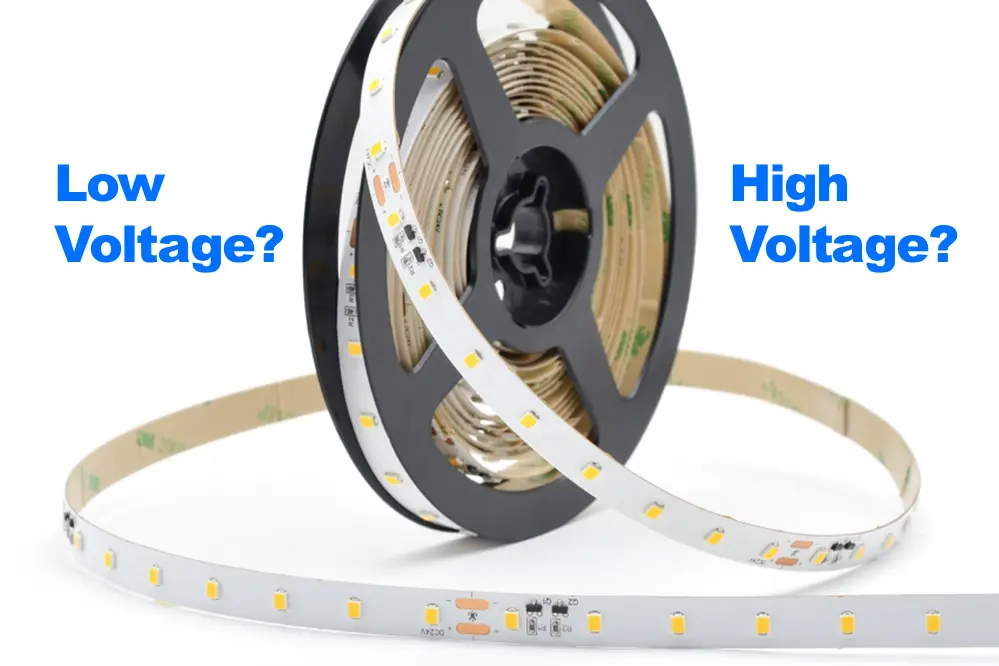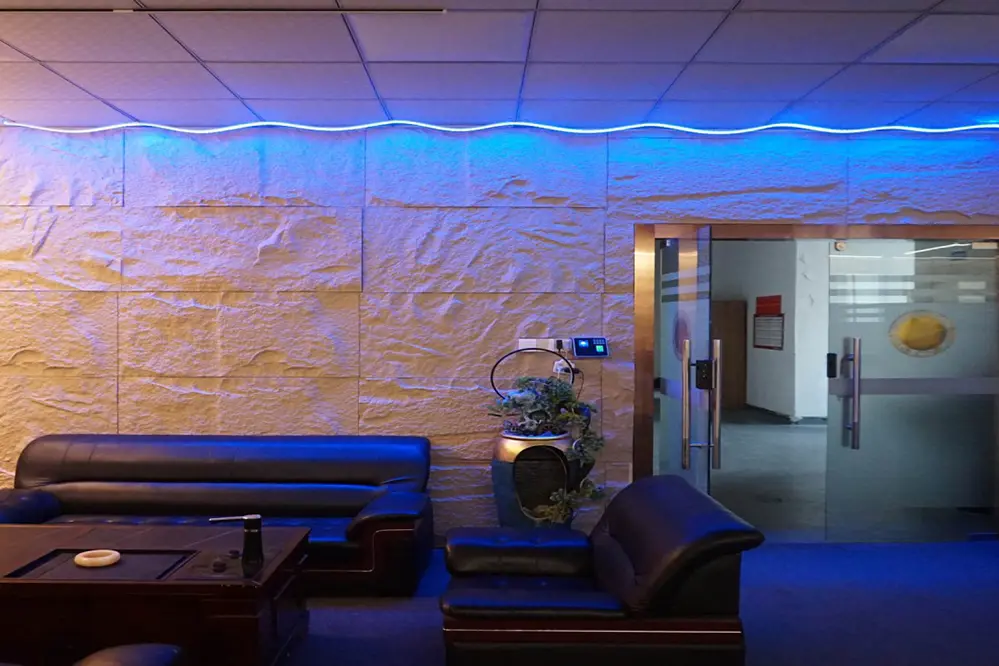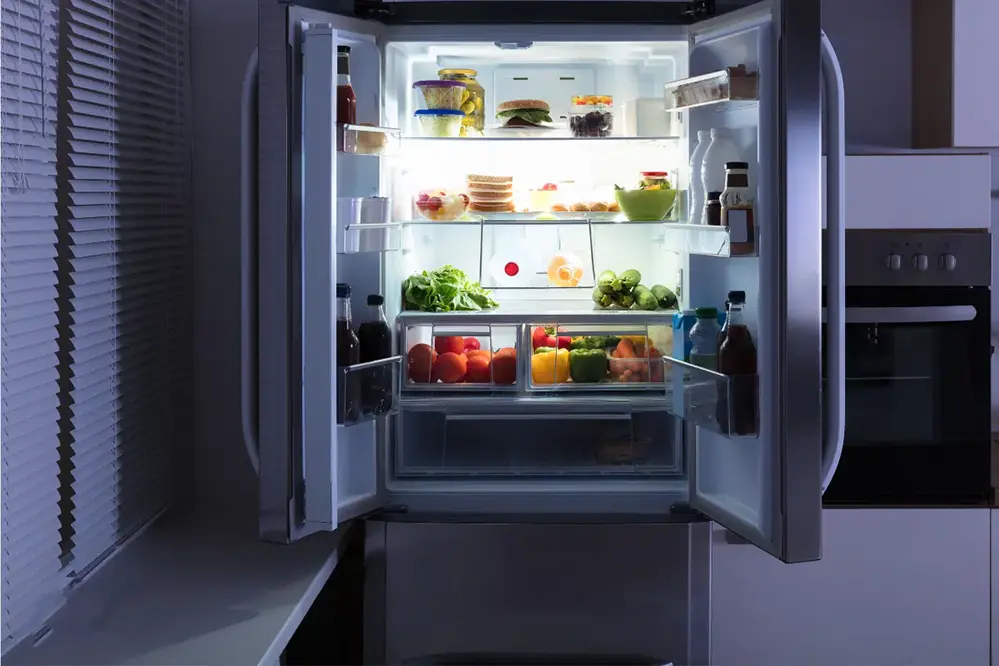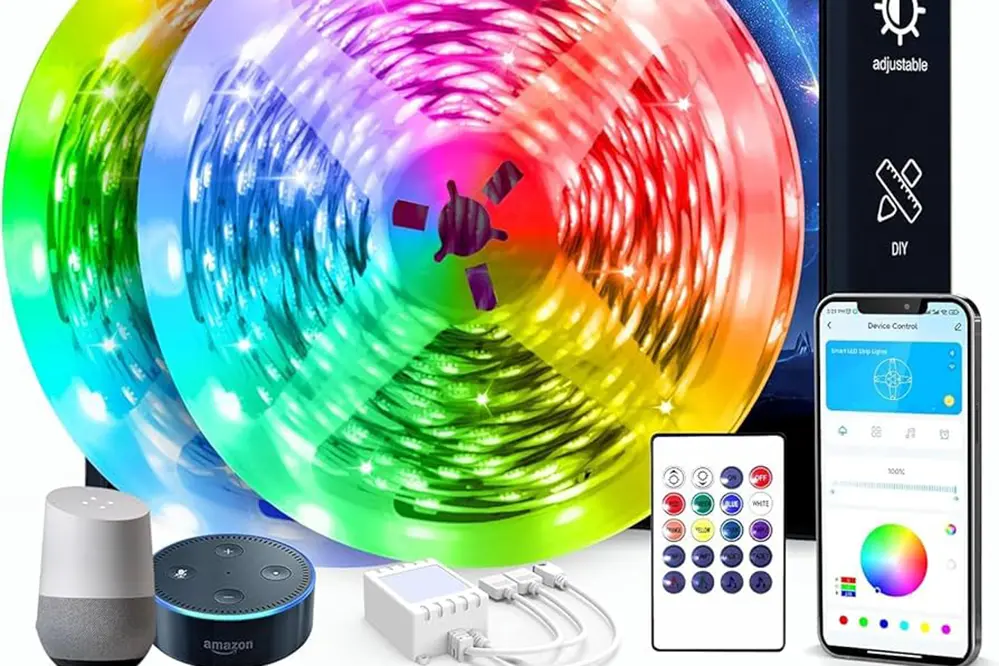When it comes to illuminating spaces with LED strip lights, understanding the difference between low voltage and high voltage options is crucial. Whether you’re a lighting enthusiast or a professional, choosing the right type of LED strip light can significantly impact the efficiency, transformer requirements, safety, and overall aesthetics of your project. In this blog post, we’ll delve into the specifics of low voltage (12V or 24V DC) and high voltage (120V or 230V AC) LED strip lights, helping you make an informed decision based on your unique needs.
LED strip lights have revolutionized the way we think about lighting, offering flexibility, energy savings, and a wide range of applications. However, the choice between low voltage and high voltage LED strips isn’t always straightforward. Each type has its own set of advantages and potential drawbacks, depending on the application. By understanding the technical differences and practical implications, you can ensure that your lighting setup not only meets but exceeds your expectations.
My name is Tom, and I’ve been immersed in the LED lighting industry since 2005. With nearly two decades of experience, I’ve witnessed the evolution of LED technology and have developed a deep understanding of its nuances. This blog post is a culmination of my extensive knowledge and hands-on experience with LED strip lights, focusing also on compatibility aspects. My goal is to provide you with clear, actionable insights that will help you make the best choice for your lighting projects.
So, if you’re ready to explore the fascinating world of LED strip lights and learn when to choose low-voltage versus high-voltage options, you’re in the right place. Let’s dive right in!
Understanding Low Voltage LED Strips
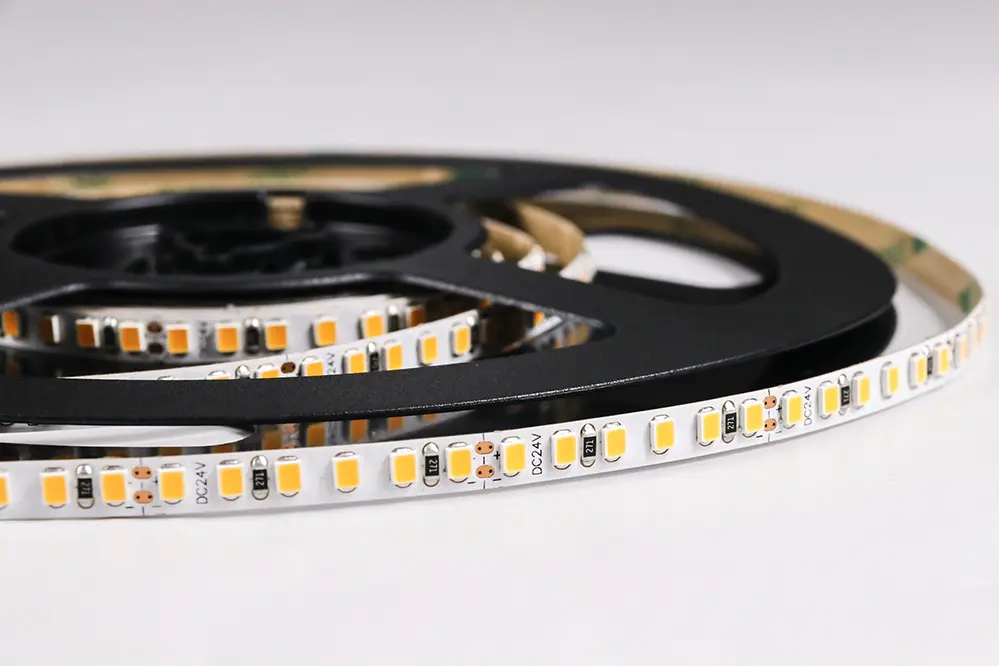
Low-voltage LED strips, often operating at 12V or 24VDC, require a dedicated driver to convert the standard household AC voltage to a lower low-voltage DC voltage. This low-voltage characteristic makes them particularly safe for various applications, including residential and automotive lighting.
In addition to their safety benefits, low-voltage LED strips offer superior flexibility, ease of installation, and can be chosen with an appropriate voltage rating for different projects. They can be cut to precise lengths without compromising their functionality, making them ideal for custom lighting projects. Moreover, the low voltage design reduces the risk of electrical hazards, which is especially critical in wet or damp environments.
Voltage Specifications (12V and 24V)
Low-voltage LED strip lights typically operate at 12V or 24V DC. This lower voltage and extended lifetime make them safer and more reliable for DIY installations and residential applications.
In terms of efficiency and power consumption, 24V LED strips generally deliver enhanced performance. This is because they can handle longer runs without significant voltage drop.
Low voltage LED strips are ideal for intricate and detailed lighting designs.
The choice between 12V and 24V LED strips often depends on the desired brightness, required power supply, and installation length. While 12V strips are suitable for shorter runs and more flexible applications, 24V strips are preferred for longer runs and projects requiring higher luminosity. Both options ensure low heat output, making them safe for diverse applications.
Energy Efficiency and Safety
Low voltage LED strip lights (12V or 24V DC) and high-voltage LED strip lights (120V or 230V AC) offer differing benefits for energy efficiency and safety.
- Energy Consumption: Low voltage LED strips typically consume less energy, making them ideal for energy-conscious applications.
- Heat Production: Low voltage LEDs generate less heat, reducing risk of overheating and associated hazards.
- Current Flow: High voltage LEDs experience lower current flow, reducing energy loss over long distances.
- Safeguards: Low voltage systems are inherently safer, especially in residential settings or damp conditions.
- Installation Complexity: Low voltage systems are simpler to install and allow for thinner cables, but may require additional transformers or power supplies.
High voltage LED strips are more efficient for extended lengths and larger installations.
Low voltage systems enhance safety, particularly in environments with potential exposure to moisture, whereas high-voltage systems are often preferred for their efficiency in large-scale applications.
Selecting between low and high voltage LED strips hinges on specific project needs, factoring in both energy efficiency and safety concerns.
Ideal Applications and Use Cases
Choosing the right LED strip is pivotal.
Low voltage LED strips, such as 12V or 24VDC, are perfect for residential settings. They offer enhanced safety and energy efficiency, making them suitable for bedrooms, living rooms, kitchens, and decorative lighting. Moreover, their lower current flow minimizes heat production, ensuring a safe environment for prolonged use.
Bathrooms benefit from low voltage strips.
Commercial spaces like restaurants often require more intense lighting. This is where high-voltage LED strips—such as 120Vac or 230Vac—shine. Their ability to cover longer distances with consistent brightness makes them ideal for large spaces, reducing the need for multiple power sources.
Outdoor installations are another area where high-voltage strips excel, providing durable lighting solutions that withstand environmental factors. With the advent of advanced control systems in 2023, using high voltage strips enables creative and impactful lighting designs, ensuring both functionality and aesthetic appeal.
Exploring High Voltage LED Strips
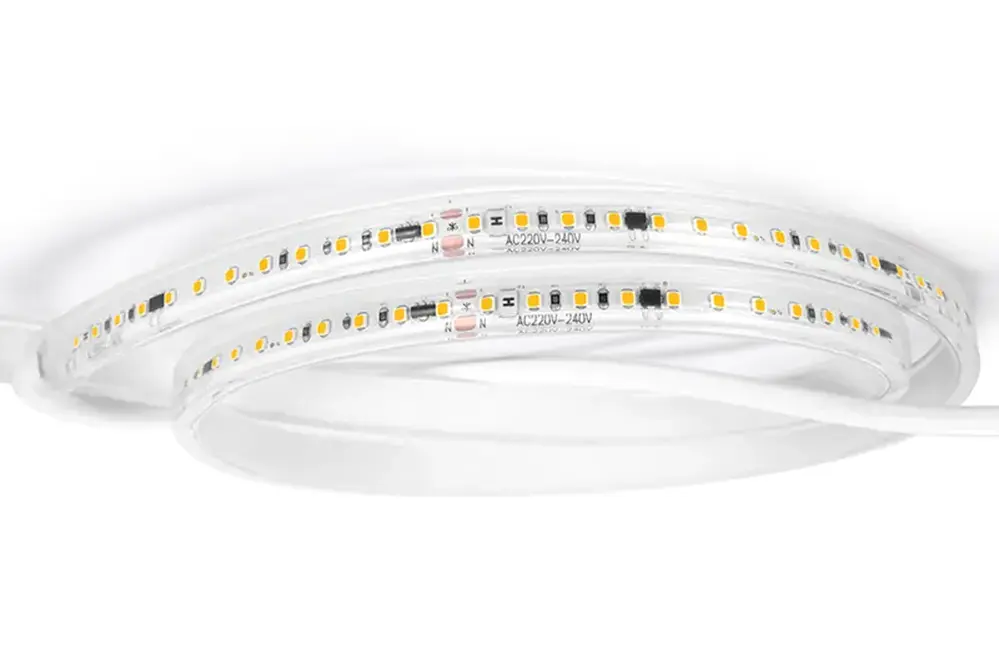
High voltage LED strips operate on 120Vac or 230Vac, making them a robust choice for extensive commercial projects. These strips are efficient in covering large areas, reducing the need for multiple connections.
Their higher power capacity ensures consistent brightness. This makes them suitable for environments where reliable and continuous lighting is crucial.
Voltage Specifications (120V and 230V)
High voltage LED strip lights operate at either 120V or 230V, offering unique benefits and considerations.
- Longer Runs: High voltage strips can cover extensive lengths without voltage drop.
- Fewer Drivers: These strips reduce the need for multiple power drivers.
- Durability: They are often more robust, ideal for exterior applications.
Efficient for large commercial spaces, these specs provide consistent brightness over greater distances.
Consider high voltage options for projects requiring extended length and minimal maintenance.
Power and Brightness
Power and brightness are key considerations in LED strip light applications.
Low voltage LED strips, typically operating at 12V or 24V DC, are known for their energy efficiency and lower heat output. These characteristics are particularly advantageous in settings where close proximity to the light source is essential, as in under-cabinet lighting or accent lighting scenarios.
They are highly versatile.
In contrast, high-voltage LED strips, operating at 120V AC or 230V AC, offer greater illumination power – ideal for projects demanding extensive light coverage with fewer installation interruptions, such as large commercial interiors or outdoor displays.
Both low and high voltage LED strips exhibit varying efficacy levels in brightness production, dictated primarily by the application context and the required intensity. While low voltage options are generally perceived as safer and more energy-efficient, high voltage equivalents provide more robust illumination, capable of spanning longer distances without significant voltage drop. Careful selection based on project requirements ensures optimal performance and energy utilization.
Ideal Applications and Use Cases
Low voltage LED strips (12V or 24VDC) are perfect for intricate, detailed projects requiring precision and safety.
- Under-cabinet lighting
- Accent lighting
- Automotive lighting
- Portable lighting solutions
- Architectural detailing
These settings benefit from reduced heat output and safer operation at closer proximity.
High voltage LED strips (120V or 230V AC) are suited for large-scale installations that require extensive light coverage.
They are ideal for outdoor lighting, commercial spaces, and any project where minimizing power supply lines is crucial.
Comparing Installation and Maintenance
When comparing installation processes, low voltage LED strips, such as 12V or 24V DC, require a transformer or driver to step down the higher mains voltage to their operating level. This added device can complicate installation, necessitating careful placement and planning. Conversely, high voltage LED strips, operating at 120V or 230V AC, connect directly to the mains power supply, simplifying the installation process by eliminating the need for additional components. However, while the initial setup might be simpler for high voltage strips, they demand rigorous insulation and protective measures to mitigate safety risks, making regular maintenance crucial to ensure sustained safe operation.
Installation Complexity
Installation complexity varies between low voltage and high voltage.
Low voltage LED strips, operating at 12V or 24V DC, require a dedicated transformer to safely reduce the mains voltage to suitable levels. This necessity introduces an additional layer to the installation process, as the transformer must be strategically positioned and adequately ventilated to prevent overheating. Consequently, professionals must carefully design the layout to accommodate both the LED strips and the transformer.
High voltage LED strips.
These strips are generally easier to install because they connect directly to the mains voltage. This direct connection eliminates the need for transformers, significantly streamlining the installation process.
The primary consideration here involves ensuring stringent safety protocols are followed. High voltage systems require well-insulated cables and secure, moisture-resistant connections to prevent any electrical hazards.
This complexity is balanced against the fact that low voltage systems, despite the need for transformers and drivers, tend to offer increased flexibility in creative applications such as under-cabinet lighting, accent lighting, and custom installations. High voltage LED strips can be less versatile but excel in scenarios demanding extensive linear illumination without complex power distribution networks.
Maintenance and Upkeep
Maintenance of LED strip lights primarily involves ensuring the integrity and performance of the lighting system over time.
- Regular Cleaning: Dust and debris can accumulate on the strips and affect light quality.
- Inspect Connections: Regularly check all electrical connections to ensure they are secure and free from corrosion.
- Check for Damage: Look for any physical damage to the LED strips, which could lead to malfunction or electrical hazards.
- Monitor Temperature: Ensure adequate ventilation to prevent overheating, which can shorten the lifespan of the LED strips.
- Replace Components: Periodically replacing worn-out drivers or transformers in low voltage systems can prevent performance degradation.
Regular maintenance ensures the longevity and consistent performance of your low-voltage LED lighting system.
High voltage LED strips generally require less frequent maintenance but necessitate thorough inspections due to their direct connection to mains power.
Always follow manufacturer recommendations for maintenance to ensure both safety and optimal performance of your LED strips.
Cost Considerations
The cost implications of choosing between low and high voltage LED strip lights are important to consider.
Initially, low voltage LED strips may seem more affordable due to their lower upfront costs, including the LED strips themselves and their power supplies. However, the expenses can accumulate when accounting for additional components like transformers and more complex wiring requirements. These necessities can increase the overall initial expenditure, reflecting the need for careful cost analysis in budget planning.
Conversely, high voltage LED strips typically showcase higher upfront costs, especially in regions where dedicated power adaptors or controllers are needed. Despite this, they often require fewer components and simpler installations, potentially lowering long-term operational costs. This simplicity can lead to reduced installation time and labor expenses, contributing to overall cost savings.
Ultimately, the selection between low and high voltage LED strips should consider the entire lifecycle cost. Professional consultation can provide an in-depth cost-benefit analysis, accounting for purchase price, installation costs, efficiency, and maintenance over the expected lifespan. Evaluating these factors ensures an informed decision that aligns with both budgetary constraints and project goals, ensuring the financial feasibility of your lighting project.
Choosing the Right LED Strip for Your Needs
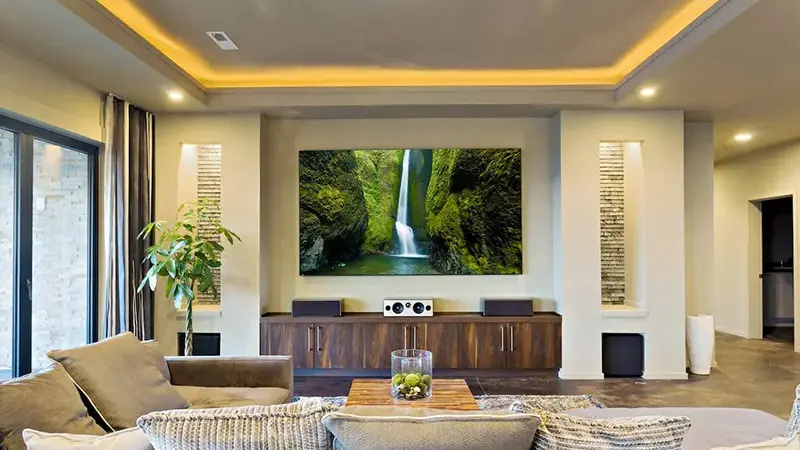
When selecting an LED strip, consider factors such as application type, installation environment, and power requirements. Low voltage, like 12V or 24VDC, is ideal for residential, task lighting, or areas needing detailed illumination.
High voltage, such as 230Vac or 120Vac, is better suited for extensive commercial settings and outdoor projects requiring longer runs without voltage drops.
Project Requirements
Your project requirements are crucial.
Before selecting LED strip lights, define the scope of your project. This includes understanding the environment, the degree of brightness required, and the length of the LED strips needed. Additionally, consider if the lighting will be installed indoors or outdoors, as this will influence the choice of water-resistant or waterproof strips.
Evaluate power sourcing.
Low voltage LED strips, typically 12V or 24VDC, necessitate a compatible power supply for safe and efficient operation. On the other hand, high voltage LED strips, usually 230Vac or 120Vac, connect directly to the mains power.
Determine ease of installation.
Low voltage strips are often more flexible and easier to handle, making them ideal for intricate layouts. Conversely, high voltage strips can cover larger distances with fewer power connections but may require more stringent safety measures.
Make sure to assess long-term operational costs, potential for dimming capabilities, and whether the lighting will need to integrate with existing systems for optimal functionality. Understanding these factors ensures that the chosen LED strips meet your project’s specific technical and aesthetic goals, while remaining cost-effective and safe.
Long-term Benefits
Investing in low voltage LED strip lights provides substantial long-term advantages due to their lower operational costs and higher energy efficiency.
High voltage LED strips also serve specific needs well, particularly in large-scale installations.
This technology minimizes heat generation, extending the lifespan of the LEDs and reducing maintenance needs. It also allows for more efficient light dispersion.
For low voltage options, the necessity of a transformer adds an initial cost but contributes to consistent performance and reduced electricity bills over time. Furthermore, advancements in dimming technology and smart controls make low voltage systems increasingly adaptable and future-proof.
Practical Decision-making
Choosing the right voltage is crucial.
Low voltage LED strips, typically operating at 12V or 24V DC, are ideal for applications where precision, control, and safety are paramount. Their lower power requirement makes them safer to install and operate, particularly in environments with high moisture or near combustible materials. Consequently, these are often preferred in residential lighting, automotive applications, and intricate architectural features.
In contrast, high voltage LED strips, such as 120V AC or 230V AC, are preferable for large, continuous runs.
These strips enable longer installations without voltage drop issues, thereby reducing the need for multiple power supplies. This makes them ideal for large commercial or industrial spaces, where maintaining a consistent light output over extended distances is critical.
When considering which type to use, assess the specific lighting requirements, taking into account factors such as the intended use, power source availability, and installation complexity. By doing so, you ensure the implementation of the most effective lighting solution tailored to your project’s needs. Each type offers unique benefits tailored to particular applications, enhancing overall performance and satisfaction.
Conclusion
Both low voltage and high voltage LED strip lights have distinct advantages and optimal use cases. Low voltage LED strips (12V and 24V DC) offer flexibility, safety, and ease of installation, making them ideal for residential, vehicular, and intricate architectural applications. High voltage LED strips (120V AC or 230V AC) are suited for extensive, continuous lighting needs. They maintain consistent illumination over long distances without multiple power supplies, perfect for commercial and industrial settings. Choosing the right LED strip light involves evaluating your project’s specific needs, such as power source availability, installation ease, and desired lighting effect. Understanding these factors ensures you make an informed decision that maximizes functionality and efficiency.
For those looking to source high-quality LED strip lights, consider contacting Unitop, a professional Chinese manufacturer specializing in LED strip lights and LED neon strips. With their expertise and extensive product range, Unitop can provide tailored solutions to meet your specific lighting needs. Reach out to Unitop to ensure your lighting projects achieve the best possible outcome.
